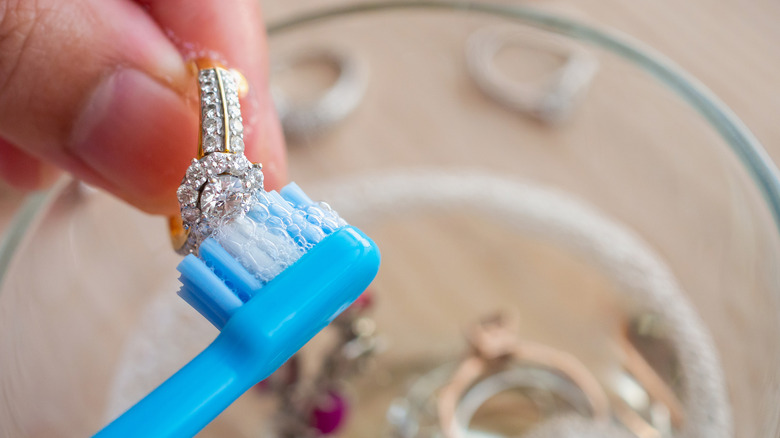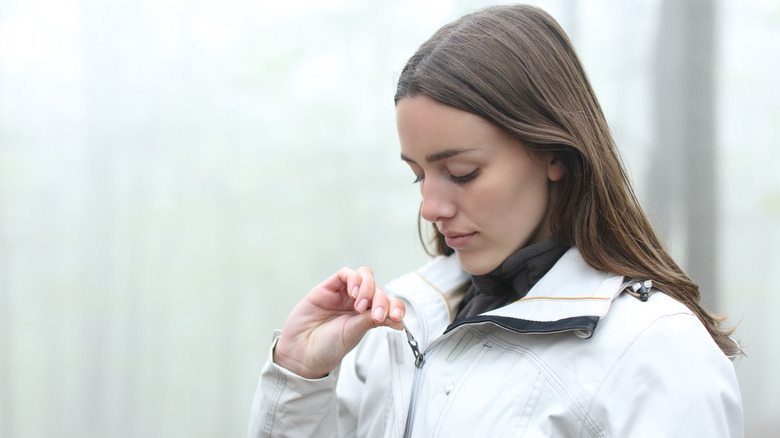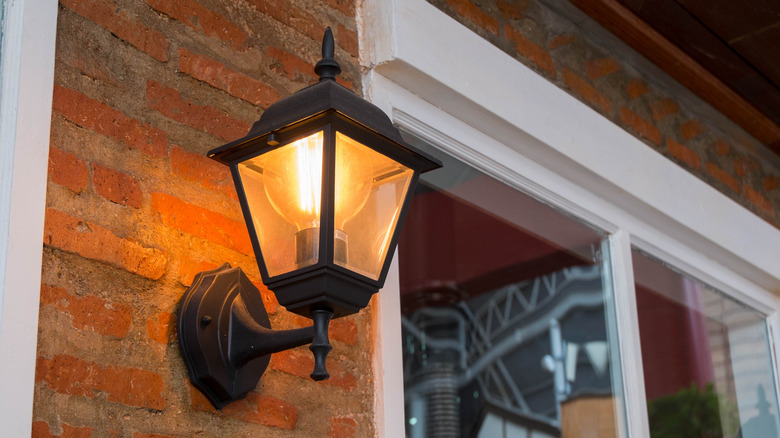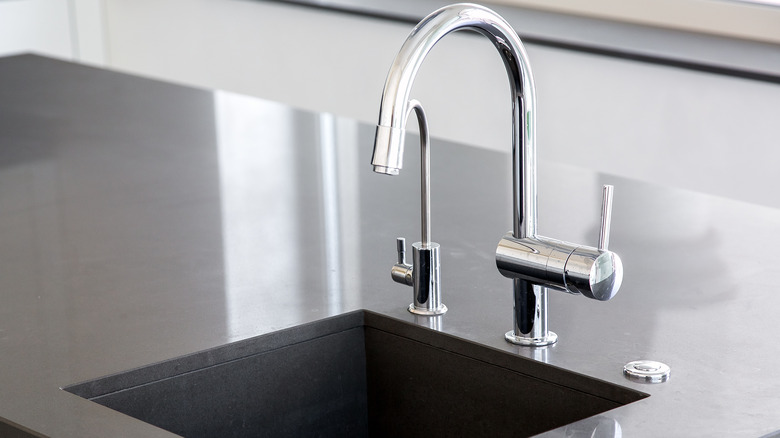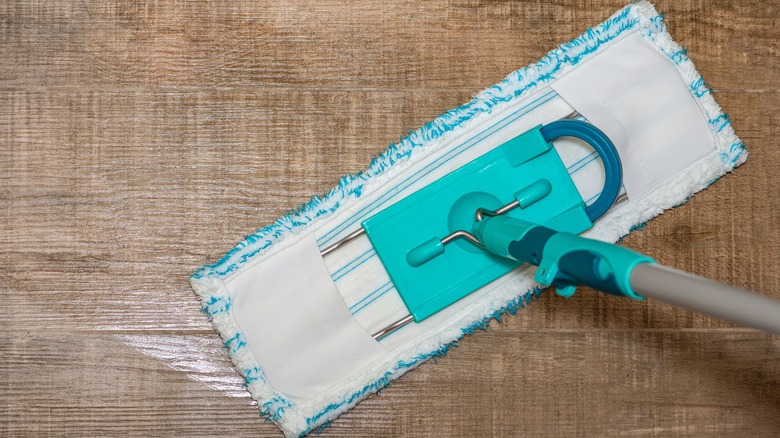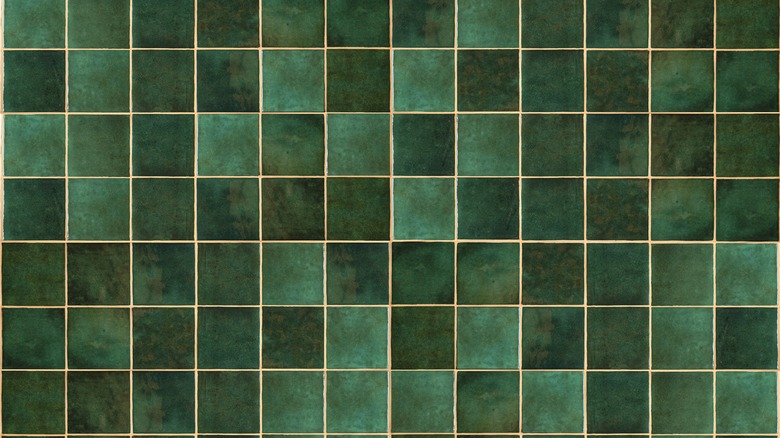25 Surprising Ways You Can Use Windex Around The Home
That familiar blue liquid in the Windex spray bottle is a standard item in many house-cleaning supply cupboards. It's the go-to favorite for cleaning windows and mirrors. But Windex also makes an array of specially formulated cleaners that perform a surprising number of functions around the home. The Windex original formula delivers a streak-free shine on glass and other surfaces due to its ammonia content. Alternatively, Windex vinegar glass cleaner provides an ammonia-free formulation using vinegar as the cleaning agent. To kill germs and viruses, you can clean many surfaces in your home with ammonia-free Windex disinfectant cleaner. For tough dirt on outdoor furniture and outside surfaces, attach Windex outdoor glass and patio concentrated cleaner to your garden hose and spray the grime away.
With multiple formulations to choose from, Windex may surprise you with the tasks it can perform. For example, did you know that Windex can unstick a zipper, loosen old wallpaper, and safely clean your diamond engagement ring? These are only three examples of the many surprising ways you can use Windex around the home.
Bring out the lustrous sparkle in your best jewelry
Windex original glass cleaner contains ammonia, the perfect cleaning agent for jewelry with hard stones, diamonds, gold, and sterling silver. In fact, jewelers recommend cleaning diamonds with Windex due to its safety and effectiveness. However, Windex should not be used to clean pearls and soft stones like opals and turquoise.
To clean a piece of diamond jewelry with Windex, it's advisable to place the item in a bowl. Spray it with Windex original formula cleaner, and let it sit for a minute. Then, use an old toothbrush with soft bristles to gently scrub the diamond's surface and the surrounding metal. Jewelry picks up oils and dust as we wear it, so brushing softly around the intricate angles of the diamond's setting helps to loosen the dirt. Next, rinse the piece of jewelry in warm, running water. (Be sure to close the sink drain to avoid losing the piece). Finish the job by drying and polishing your diamond jewelry with a lint-free cloth.
Unstick things that get stuck
Have you ever worn a ring you couldn't get off your finger? Or, have you ever tried to put on a jacket with a stuck zipper? Surprisingly, you can spritz the stuck object with Windex, and it will loosen up immediately. When a ring gets stuck on your finger, yanking and pulling it will not help. In fact, these actions may cause your finger to swell, and the ring becomes even more stuck. Spray Windex on your finger and the ring, and it will slide right off due to the lubricating action of the cleaner. Although ammonia can cause skin irritation, the small amount in a spritz of Windex does not harm your skin. However, as a precaution, you might want to wash your hand after the ring is safely removed from your finger.
In the case of a jammed zipper, the lubricating effect of Windex allows the tiny metal teeth to slide against each other and become unstuck. Additionally, the cleaning agents in Windex clear away dirt, dust, and oils that might cause the zipper to jam.
Spray on Windex to remove old wallpaper
Many DIYers use hot water and steamers to remove old wallpaper. But these methods quickly become an annoying mess. Instead, you can use Windex original glass cleaner to loosen the glue that holds the old wallpaper in place. The spray's solvent dissolves not only dirt and grime, but also tacky glue.
Follow a few simple steps to remove the old wallpaper successfully. First, scour and peel a few strips of the old paper to expose the wall in a few places. Next, spray an area of the wall with Windex and let it soak in for several minutes. Then, scrape the old wallpaper off with a 6-inch putty knife. For extra convenience in your wallpaper removal job, try Windex foaming glass cleaner. It's formulated to adhere to vertical surfaces, so it may cling to the wall more easily than the liquid spray does. This allows time for the cleaner to soak into the old wallpaper before it runs down the wall.
Clean your microfiber couch with Windex
Microfiber fabric coverings on couches, chairs, and stools offer the luxury look of suede. Yet, they're soft, stain resistant ,and durable, making them a top choice for households with kids and pets. Microfiber is a synthetic type of fiber, generally made of polyester and nylon. On microfiber, you can use Windex original formula or one of the ammonia-free formulations to clean the dirt and messes left behind from tough, daily use.
First, vacuum the couch to remove loose dirt and crumbs. Then, spray Windex to saturate an area approximately 2 feet wide by 2 feet long. Just ensure not to soak it, or it might leave water marks. Scrub the area with a nylon bristle brush, using both back-and-forth and circular motions. Wipe with a microfiber cloth to remove excess Windex. Next, move on to an adjacent area of the couch and repeat the process. Continue until the entire couch is clean. The microfiber will appear darker while it's still wet from the Windex. It takes about an hour to fully dry and return to its original color.
Pre-treat laundry stains with Windex
You might have a cupboard full of cleaning supplies and another closet full of laundry supplies. Why not simplify your routine by using one product for both cleaning and laundry? The Windex you use to clean your windows is also an excellent stain remover for non-silk garments and household laundry . The original formula contains ammonia, and Windex vinegar glass cleaner has white vinegar as a cleaning agent. Both ammonia and vinegar are natural stain removers, and Windex includes them in well-diluted formulas that will not harm fabrics. Horrifying fabric stains such as spaghetti sauce, red wine, and catsup respond well to Windex as a pre-treatment before washing.
Before laundering, spray the stain with Windex original formula cleaner. If you're pretreating a white or light-colored piece of fabric, you might be concerned about the spray's blue liquid dye. In that case, you can substitute the colorless Windex vinegar formula to avoid transferring the blue color to your garment. After thoroughly soaking the stain with the spray, let it sit for about 10 minutes. Then launder the item, following your regular routine.
For carpet stains, spray with Windex, then blot
It's a fact of life: carpet stains happen. You don't need a special carpet cleaner when you have a bottle of Windex around the house. It removes carpet stains caused by food and drink spills, as well as pet urine and even blood. You can spray Windex directly onto the carpet stain to saturate the area. Then, blot with a clean towel or microfiber cloth to remove the Windex liquid and the stain. Avoid scrubbing, as it spreads the stain, working it deeper into the carpet fibers. Repeat spraying Windex and blotting with a cloth until the discoloration is eliminated.
Alternatively, you can mix equal parts of Windex and warm water in a bowl. Dip a cloth or towel into the liquid, squeeze out the excess water, and blot the carpet stain with the cloth. Refresh the cloth with the Windex-and-water mixture and continue blotting until the stain is removed. Then, moisten the cloth with clear water and blot to remove any residual Windex left in the carpet fibers. Follow up by drying the area with a clean, dry towel.
Put a shine on your patent leather shoes and handbags with Windex
For an elegant, dressy vibe, nothing beats the shine of patent leather. Fortunately, a quick spritz and wipe-down with Windex are all you need to clean and shine your patent leather shoes and handbags. According to Satra Technology, patent leather originated in the 18th century when artisans treated natural leather with boiled whale oil to create a shiny, water-resistant finish. Today's patent leather shoes and handbags are made from cattle hide or polyurethane leather (vegan leather) coated with acrylic.
To clean patent leather, simply spray it with Windex original formula or with one of the ammonia-free formulations, such as Windex vinegar or multi-surface cleaner. After spraying, wipe the item with a soft, lint-free cloth. Microfiber cloths are excellent for this purpose since they reduce streaks. Be sure to entirely remove the Windex liquid. Then, buff the item with a dry cloth to bring out the shine. That's it! Super simple.
Windex works as an occasional bug killer
Did you know you can get rid of pesky bugs by spraying them with Windex? It instantly kills ants, spiders, flies, and other small critters. Some people prefer Windex over insecticides because it's a more economical choice and serves multiple purposes around the home. Additionally, Windex is eco-friendly and does not produce the strong smell of insecticides. So, in a pinch, grab the Windex when you see an unwanted bug in your home.
However, Windex is not a substitute for high-quality pesticides. Although it's a handy and effective bug spray for occasionally invasive small insects, it does not serve as a repellent. The vinegar and ammonia in Windex formulations are lethal to bugs, but they are heavily diluted in the Windex cleaning solutions. Therefore, the cleaner is not an effective overall treatment for pest control. If you have an insect infestation in your home, don't count on Windex to handle the problem.
Use Windex to clean vinyl siding
Vinyl siding is an attractive covering for the exterior walls of homes. But it loses its curb appeal when dirt and stains build up. Both Windex original formula with ammonia and Windex vinegar formula clean vinyl siding quickly and easily without damaging the material. Additionally, Windex will not harm the plants and grass that grow close to your home's exterior walls.
Start by removing loose dirt with a spray of water from a garden hose. Then, to remove stubborn grime and stains from small areas of siding, simply spray with Windex from the handheld bottle. Scrub with a sponge, cloth, or soft-bristle brush, avoiding abrasive textures that might damage the vinyl. Follow up by hosing the area again with clear water.
If you're cleaning large areas of your vinyl siding, the best method is to use Windex outdoor sprayer. Attach your garden hose to the specially designed top of the bottle and turn the dial to rinse. After rinsing, turn the dial to clean and spray the Windex solution onto your siding. Allow the solution to sit on the siding for about 15 seconds. Then, turn the dial to rinse and spray the vinyl to remove the grime along with any residual cleaning solution.
Clean lighting fixtures with Windex vinegar glass cleaner
Indoor lighting fixtures collect dust. Outdoors, the garden's solar lights and your porch lanterns become coated with pollen, dust, cobwebs, and dirt. Clean the lights and the surrounding surfaces with either Windex vinegar or Windex ammonia-free glass cleaner. Due to their ammonia-free formulations, these versions of Windex will not damage the metal in your lighting fixtures.
Start by turning off the power supply to the lighting fixtures. This is generally accomplished by flipping switches in your home's circuit breaker panel. Remove the light bulbs and any removable parts of the fixtures. Then, spray one of the ammonia-free Windex cleaner formulations onto a microfiber cloth. Use the cloth to wipe all surfaces of the fixtures as well as the light bulbs. Spray more Windex onto the cloth as needed. To complete the job, wipe all surfaces with a dry, lint-free cloth. When all parts are dry, reassemble your lighting fixtures, replace the bulbs, and reconnect the power supply.
Refresh your patio furniture with Windex outdoor sprayer
Most outdoor furniture is made from durable, synthetic materials like polyvinyl chloride (PVC), polyethylene, nylon, and high-density polyethylene (HDPE). Windex is a safe and effective cleaner for these materials. However, you should avoid the Windex original glass cleaner for sprucing up your patio furniture. Ammonia can be particularly damaging to wood decks and patio furniture made from wood. Therefore, you'll want to avoid using the original blue Windex cleaner on those surfaces.
You can remove pollen, dust, mud, and sticky messes from outdoor furniture with the Windex cleaner that's made for outdoor applications. Its ammonia-free formulation makes it safe for outdoor surfaces. The Windex outdoor sprayer attaches to your garden hose to make quick work of washing your patio furniture. Simply rinse, wash, and rinse again. The dial on the top of the spray bottle makes it easy to breeze through those three steps. Do the job on a sunny day, and your patio furniture will be clean and dry in no time.
Use Windex to remove sticker residue
One of life's little frustrations arises when you try to peel a label from a glass object only to find a sticky glue residue that doesn't want to come off. When sticker gunk is left behind on glass, Windex comes to the rescue. According to SC Johnson, the original formula contains a surfactant cleaning agent called 2-hexoxyethanol, which surrounds dirt and loosens it, along with a solvent called isopropanolamine, which dissolves residue. Additionally, ammonium hydroxide (household ammonia) contributes to the cleaning strength of Windex original glass cleaner. When it comes to removing glue residue, these three ingredients work together to dissolve and lift the glue from glass or other hard surfaces.
You'll need a razor-blade scraper along with Windex to work on stubborn glue residue. Simply spray with Windex and wait five minutes for the liquid to soak into the glue. Then, scrape off the loosened residue with the razor blade. Repeat this process until all parts of the sticker are removed.
Make chrome faucets and fixtures sparkle
Windex removes fingerprints, streaks, soap scum, and water spots from chrome faucets and fixtures. For the safest results, use one of the ammonia-free formulations, including Windex vinegar glass cleaner, Windex ammonia-free glass cleaner, and Windex disinfectant cleaner multi-purpose. Although heavy doses of ammonia are known to damage chrome, the small amount of diluted ammonia in Windex's original formula is not enough to harm your faucets and fixtures. However, using the ammonia-free products will provide extra peace of mind.
Spray Windex on chrome faucets and fixtures and wipe them with a microfiber cloth. After the surface is clean, you can bring out the shine by rubbing it with a dry cloth. If you have wood or natural stone countertops adjacent to your faucet and fixtures, be careful about overspray if you are using the Windex original formula with ammonia. In this case, you can spray the cleaner on the microfiber cloth and use it to clean and polish the chrome, thus avoiding the cleaner's contact with the stone countertops.
Clean toilets and bathtubs with Windex
After you clean your bathroom mirror with Windex, spray it in the bathtub and the toilet. Just make sure to use the correct Windex formula based on your tub's material. Many bathtubs are made with a porcelain-enamel coating over a steel or iron base. Ammonia is a safe cleaning agent for this type of finish. Therefore, the Windex original formula works well on porcelain tubs. Be aware that Windex vinegar glass cleaner is not a good choice for porcelain, as the vinegar may damage the outer finish. On the other hand, Windex vinegar glass cleaner is a safe and effective choice for fiberglass and acrylic bathtubs. These materials respond well to vinegar as a cleaning agent. However, do not use Windex original formula cleaner on fiberglass and acrylic, as the ammonia might eat into these finishes.
For stains in a porcelain toilet bowl, spray Windex's original formula and let it sit for about 10 minutes. Then, scrub with a nylon-bristle toilet brush and flush. You'll find that the blue stuff in the spray bottle works as well as a toilet bowl cleaner.
Clean stove tops and countertops with Windex multi-surface cleaner
Windex makes quick work of cleaning the kitchen. With the ammonia in Windex original glass cleaner, any glass surfaces in your kitchen will come out clean and streak-free. However, due to the risk of damage, ammonia and vinegar should not come in contact with some kitchen surfaces. These surfaces include natural stone countertops such as granite, quartz, and marble as well as glass and ceramic stove tops. Additionally, due to its ammonia content, Windex's original glass cleaner mustn't come in contact with surfaces for food preparation and serving.
To avoid the possibility of damaging these materials, it's best to use either Windex disinfectant cleaner multi-surface or Windex ammonia-free cleaner for kitchen surfaces. Due to their ammonia-free and vinegar-free formulations, they clean thoroughly without the risk of adverse effects on natural stone and cooktops made from glass or ceramic. In addition to its cleaning prowess, Windex disinfectant cleaner multi-purpose kills various bacteria and viruses that cause illnesses. While cleaning the kitchen, you can take an important step toward protecting the health of your family members by using the disinfectant formula.
Kill mold and mildew on household surfaces
Windex original glass cleaner is an inexpensive option to kill mold and mildew around your home. Both mold and mildew are living fungi that spread via microscopic spores floating through the air. Mold is particularly damaging to the materials in your home, and it can cause respiratory health problems for the inhabitants. Windex original glass cleaner contains ammonia, an effective agent for killing the fungi that cause mold and mildew growth in moist areas around the home. Windex vinegar glass cleaner is a good second choice for killing mold and mildew since it is a mildly acidic cleaning agent. It's best to use these cleaners on hard surfaces, avoiding wood and other soft, porous materials like drywall and grout.
It's also a great cleaner to prevent mold and mildew from forming in the first place. Continually wipe down prone areas to help eliminate the threat. It's also important to open windows and doors for ample ventilation when using these products. Additionally, you should wear gloves and a mask over your mouth and nose. These precautions help avoid the health risks of contacting mold and strong cleaning agents.
Banish germs and viruses from sickroom surfaces
It's not necessary to disinfect the surfaces in your home on a daily basis. For most purposes, regular cleaning products will keep your home fresh and sanitary. But when a family member is sick, you want to take precautions against spreading the illness-causing germs or viruses to the rest of the house. Use Windex disinfectant cleaner to make household surfaces germ-free, especially in the sick room and the bathroom. This Windex cleaning formula does not contain ammonia or vinegar, so it's safe for most surfaces.
According to Windex, the cleaning agents in the disinfectant formula kill a wide variety of germs and viruses. These include staph, salmonella, pneumonia, strep, common cold germs, and the H3N2 flu virus. It's a good idea to keep the Windex disinfectant cleaner on hand to sanitize your home surfaces whenever a family member contracts a contagious illness.
Wash linoleum or vinyl floors with Windex
To keep your utility closet from overflowing with multiple products, you can use Windex vinegar glass cleaner as an effective product for your floors. Cleaning experts recommend diluted vinegar as a cleaner-of-choice for vinyl and linoleum materials. Instead of mixing vinegar and water in a bucket and washing the floor with a mop or cloth, it's super-easy to spray and wipe Windex vinegar glass cleaner, using it as a floor cleaner. However, avoid using Windex's original glass cleaner, as the ammonia may damage vinyl and linoleum.
Start by sweeping or vacuuming the floor to remove loose dirt and debris. Then, spray Windex vinegar glass cleaner onto the floor and wipe with a dry, disposable mop pad. Work in small sections approximately 4 feet wide by 4 feet long, moving across the entire floor until it's all clean. Change the dry mop pad as often as necessary to ensure you're wiping with a clean and dry disposable cloth.
Sanitize trash cans with Windex disinfectant cleaner multi-surface
Trash cans harbor bacteria and viruses as well as sticky messes. For occasional cleaning and sanitizing, you can empty your trash cans and spray them inside and out with Windex disinfectant cleaner multi-purpose. This antibacterial cleaner kills 99.9% of bacteria while it breaks down dirt and grease. The formula is ammonia-free and safe for most hard surfaces, including stainless steel and plastic.
After spraying the cleaner, wipe the surfaces with a dry cloth or a paper towel. For indoor trash cans, you can leave behind a fresh fragrance by using one of the Windex disinfectant sprays that include a Glade scent additive. If you're cleaning outdoor trash cans, you can start the job by emptying the cans and spraying them inside and out with water from a garden hose. This step will remove loose dirt and debris. Then, spray with Windex disinfectant cleaner and wipe with a dry cloth or an old towel.
Clean ceramic and porcelain tile with Windex ammonia-free formulas
When cleaning the kitchen and bathroom, don't forget that ammonia-free Windex formulas work well on multiple surfaces, including ceramic and porcelain tiles. The tiles are installed with grout joints between them. Some cleaning experts advise against using ammonia products to clean these types of surfaces because ammonia erodes grout over time. Although Windex's original glass cleaner contains ammonia as a cleaning agent, several other Windex formulas do not. Therefore, if you want the best cleaning outcomes for both the tile surfaces and the grout between them, it's advisable to use one of these products: Windex vinegar glass cleaner, Windex ammonia-free glass cleaner, or Windex disinfectant cleaner multi-surface.
To clean ceramic and porcelain tiles, start by sweeping, vacuuming, or wiping the area with a damp cloth. This step removes loose dirt and dust. Then, spray the tiled area with Windex and wipe it with a clean microfiber cloth. If you're cleaning a tile floor, use a mop with a dry, disposable mop pad.
Degrease the grimiest surfaces in your kitchen with Windex
Some of the surfaces in your kitchen appear to attract and collect greasy scum. These include exhaust fans, stove hoods, and light fixtures. While you can wash these with water and soap, it might take some extra elbow grease. Instead, you can choose Windex original glass cleaner, Windex vinegar glass cleaner, or Windex disinfectant cleaner multi-surface. Keep in mind that the original formula contains ammonia. Therefore, it's not a good choice for stainless steel surfaces.
Spray liberally to coat the greasy surfaces with the Windex cleaner of choice. Allow it to sit on the surface for about 10 minutes. Then, wipe clean and follow up by rinsing with clear water and drying with a cloth. The rinsing step is only needed for food preparation surfaces. For example, you can skip rinsing the hood of your stove, but you would want to rinse your kitchen countertop.
Clean and disinfect children's toys with Windex
From crayon marks to smeared peanut butter, children's toys collect an array of sticky messes. And we all know that babies and toddlers tend to put toys in their mouths. Therefore, cleaning and sanitizing toys is important for parents and caregivers. For thorough cleaning and peace of mind, use one of the ammonia-free Windex cleaning formulations. These include Windex disinfectant cleaner multi-surface, Windex vinegar glass cleaner, and Windex ammonia-free glass cleaner. Of course, the disinfectant variety will kill the greatest quantity of bacteria and viruses, offering greater peace of mind for protecting children's health.
Windex ammonia-free cleaning products are safe for plastic, metal, and wood toys. First, rinse with water and wipe the toys' surfaces to remove loose dirt. Be sure that bath toys do not retain water in their hollow interiors, which can lead to dangerous mold growth. Then, spray the toys liberally with Windex and let the cleaning product sit on the surfaces for about five minutes. Next, scrub with a toothbrush or a dish scrubber. Rinse the toys with clear water and dry them with a towel or microfiber cloth. Finally, allow the toys to sit out and air dry before returning them to the playroom.
Clean the dry-erase board in your home office or children's playroom
Dry-erase boards have migrated from the classroom into our homes, and they serve a multitude of convenient functions for busy families. You can use Windex to clean dry-erase boards (sometimes called whiteboards) without damaging the surfaces. To start, wipe the dry-erase board with a clean microfiber cloth to remove the markings. Then, spray the entire surface with Windex and wipe again with a clean, dry cloth.
Most modern dry-erase boards are constructed from aluminum or other rigid material coated with porcelain or enamel. You can safely use any of the Windex formulations on these types of dry-erase boards, including Windex original glass cleaner with ammonia. However, some dry-erase boards are coated with melamine, and ammonia is a potentially damaging cleaning agent for these surfaces. Therefore, Windex vinegar or ammonia-free glass cleaner would be the best choice for a melamine-coated whiteboard.
It's okay to clean home decor objects with Windex
Those beloved family heirlooms and tchotchkes that we keep in our homes collect dust and dirt over time. You can clean items made from glass, ceramic, and porcelain with Windex original glass cleaner. It will not damage those surfaces. Even the intricate pieces in a crystal chandelier come out sparkling clean after you spray them with the Windex original formula and wipe them with a microfiber cloth.
You don't need to rinse your home decor objects unless you plan to use them to serve food. In that case, rinse the objects thoroughly with clear water and wipe them dry. If you're nervous about using ammonia on fragile heirlooms, you can opt for Windex vinegar glass cleaner or Windex ammonia-free glass cleaner. These formulations deliver excellent cleaning results without the harshness of ammonia as a cleaning agent.
Clean your car inside and out with Windex
Windex is a handy cleaner for sprucing up your automobile, but the original formula with ammonia might be too harsh for some of your car's interior and exterior surfaces. Instead, use the ammonia-free formulations, including the Windex vinegar spray or ammonia-free glass cleaner. These products are safe to clean your tinted car windows without damage. Simply spray with the cleaner and wipe with a dry microfiber cloth. Keep in mind that it's best to clean your tinted windows when they are cool and away from direct sunlight to minimize streaking.
Additionally, the ammonia-free versions of Windex make short work of cleaning your car's non-leather seats and other interior surfaces. Don't forget those grimy cup holders as well as the dashboard and interior sides of the car doors. Simply spray on Windex and wipe with a microfiber cloth. However, it's best to avoid using a liquid spray on the screen of your navigation system. Instead, clean your car's interior screens with Windex electronics wipes.
Windex cleaners are useful and versatile for so many purposes other than washing windows. The original formula with ammonia and the newer ammonia-free formulas help cut down on the number of products in your cleaning arsenal. Additionally, you can rest assured you're using the best cleaning agents that won't damage the surfaces in your home.

